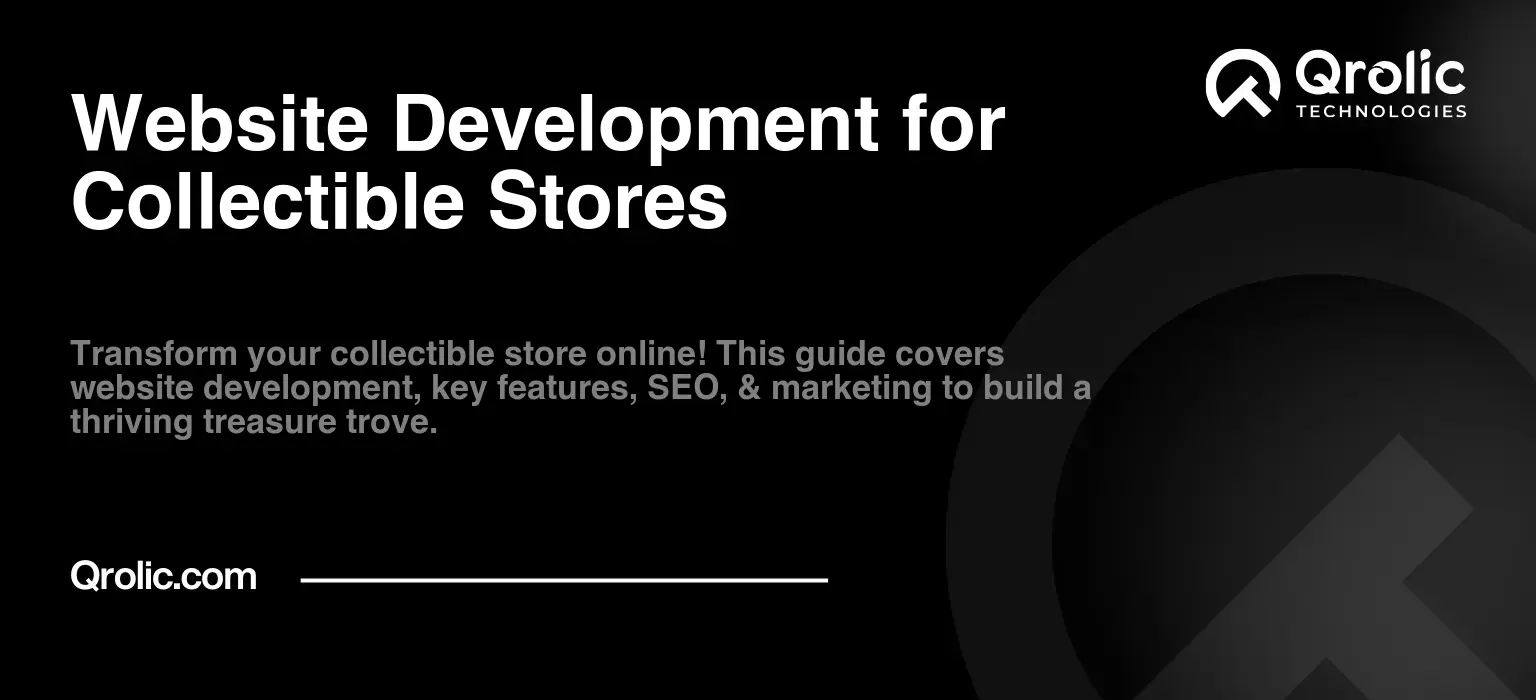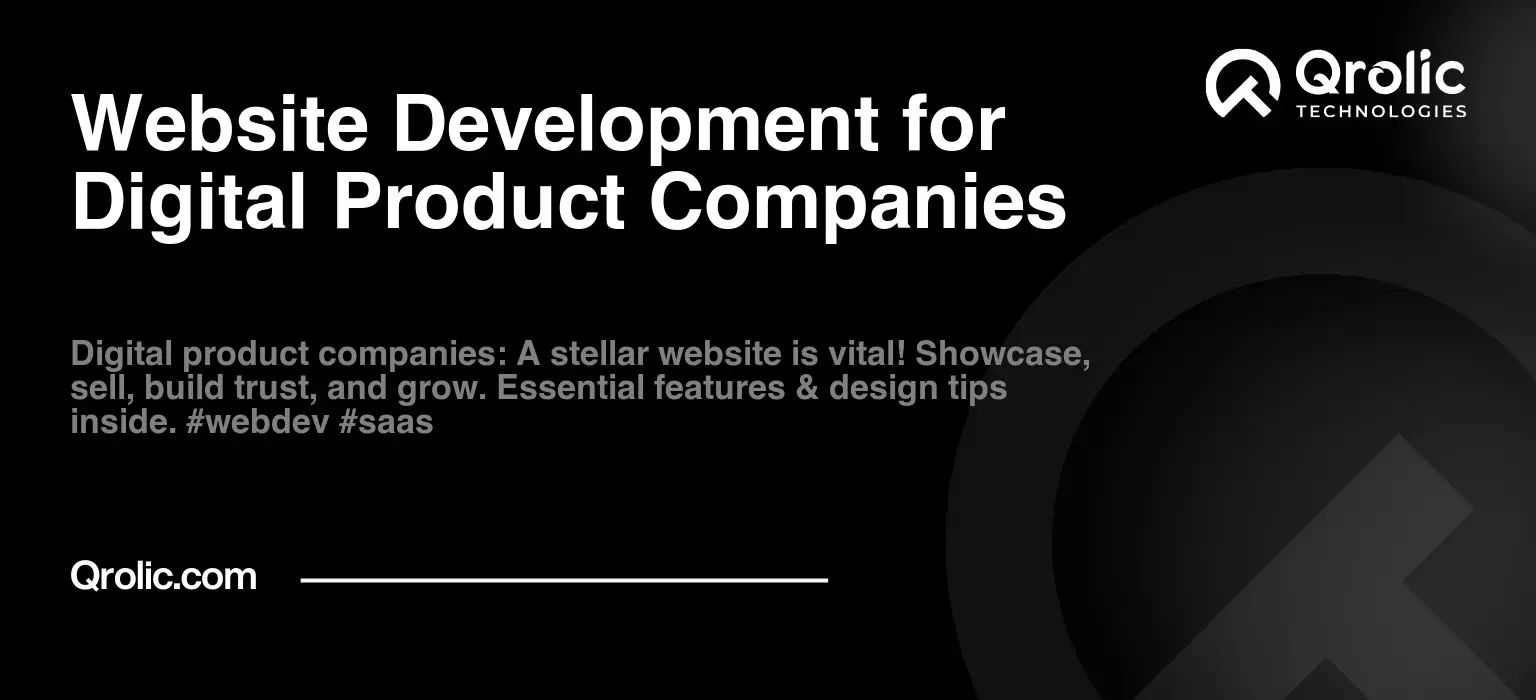Quick Summary:
- Your website is vital for agency success and first impressions.
- Showcase your best work with stunning visuals and clear stories.
- Use SEO and clear calls to action to attract and capture leads.
- Future-proof by focusing on user experience and new technologies.
Table of Contents
- The Cornerstone of Your Creative Empire: Why Your Agency Needs an Exceptional Website
- First Impressions Matter: Projecting Expertise and Creativity from the Get-Go
- Show, Don’t Just Tell: Showcasing Your Award-Winning Campaigns
- Attracting the Right Clients: Driving Traffic and Generating Leads
- Crafting a Masterpiece: Key Elements of an Effective Advertising Agency Website
- Homepage: The Digital Front Door
- About Us: Telling Your Agency’s Story
- Services: Defining Your Expertise
- Portfolio: The Showcase of Your Success
- Blog: Your Platform for Thought Leadership
- Contact Us: Making it Easy to Connect
- SEO Strategies for Advertising Agency Websites: Ranking Higher, Attracting More Clients
- Keyword Research: Understanding What Your Clients Are Searching For
- On-Page Optimization: Making Your Website Search Engine Friendly
- Off-Page Optimization: Building Authority and Credibility
- Technical SEO: Ensuring Your Website is Crawlable and Indexable
- The Power of Visual Storytelling: Captivating Website Design for Advertising Agencies
- Embracing Minimalism: Less is Often More
- Interactive Elements: Engaging Visitors and Creating a Memorable Experience
- Motion Graphics and Animation: Adding Visual Flair and Dynamism
- Mobile-First Design: Prioritizing the Mobile Experience
- Measuring Success: Key Metrics to Track and Analyze
- Website Traffic: Understanding Your Audience
- Lead Generation: Measuring Conversion Rates
- Engagement Metrics: Gauging User Interaction
- SEO Performance: Tracking Your Search Engine Rankings
- Tools for Tracking and Analyzing Website Performance
- Qrolic Technologies: Your Partner in Creating Exceptional Advertising Agency Websites
- Our Expertise: Delivering Cutting-Edge Web Solutions
- Why Choose Qrolic Technologies?
- Let’s Build Your Digital Masterpiece
- Future-Proofing Your Website: Adapting to the Ever-Evolving Digital Landscape
- Embracing Emerging Technologies
- Focusing on User Experience (UX)
- Prioritizing Accessibility
- Staying Ahead of the Curve
The Cornerstone of Your Creative Empire: Why Your Agency Needs an Exceptional Website
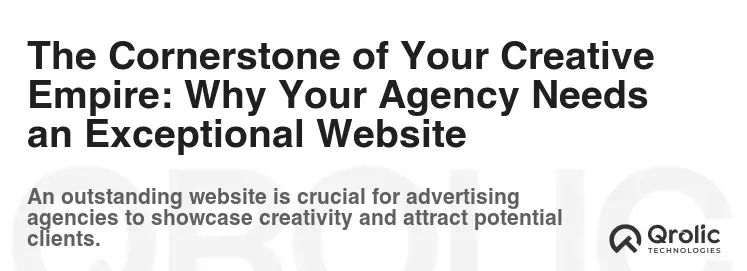
In today’s digital landscape, your advertising agency’s website isn’t just a digital brochure; it’s the pulsating heart of your brand, the first impression you make, and the ultimate driver of new business. It’s the virtual handshake, the captivating pitch, and the persuasive portfolio all rolled into one. But why is a truly exceptional website so crucial for an advertising agency in particular?
First Impressions Matter: Projecting Expertise and Creativity from the Get-Go
Potential clients are sophisticated and discerning. Before they even consider picking up the phone, they’re scrutinizing your website. It needs to instantly scream “we get it” and “we can do it.”
- Visual Appeal is Non-Negotiable: Your website should be a testament to your design prowess. It needs to be visually stunning, reflecting current trends and showcasing your unique aesthetic. A dated or poorly designed website immediately signals that you’re out of touch, turning away potential clients before you even have a chance to impress them.
- Beyond Aesthetics: Usability is Key: A beautiful website is useless if it’s difficult to navigate. Potential clients need to find what they’re looking for quickly and easily. Intuitive navigation, clear calls to action, and a seamless user experience are essential.
- Demonstrating Authority and Thought Leadership: Your website is the perfect platform to showcase your expertise. Blog posts, case studies, white papers, and thought leadership pieces demonstrate your understanding of the industry and establish you as a trusted advisor.
Show, Don’t Just Tell: Showcasing Your Award-Winning Campaigns
Advertising is a visual medium. Your website needs to showcase your best work in a compelling and engaging way. A static portfolio simply won’t cut it.
- High-Quality Imagery and Video: Invest in professional photography and video to showcase your campaigns in their best light. Don’t skimp on this – it’s a direct reflection of the quality of your work.
- Case Studies That Tell a Story: Don’t just present the facts and figures. Tell the story behind each campaign. What was the challenge? What was your strategy? What were the results? This allows potential clients to understand your thought process and see how you can solve their problems.
- Interactive Portfolio Elements: Consider incorporating interactive elements into your portfolio, such as before-and-after sliders, video testimonials, and interactive timelines. This will make your portfolio more engaging and memorable.
Attracting the Right Clients: Driving Traffic and Generating Leads
Your website shouldn’t just look good; it should also be a powerful lead generation tool. By optimizing your website for search engines and incorporating effective calls to action, you can attract the right clients and convert them into paying customers.
- Search Engine Optimization (SEO): Ensure your website is easily found by potential clients searching for advertising agencies online. Keyword research, on-page optimization, and link building are all essential components of a successful SEO strategy.
- Compelling Calls to Action: Guide visitors through your website and encourage them to take the next step. Use clear and concise calls to action, such as “Get a Free Consultation,” “Download Our Case Study,” or “Contact Us Today.”
- Lead Capture Forms: Capture valuable leads by offering valuable content in exchange for contact information. This could include e-books, white papers, checklists, or webinars.
Crafting a Masterpiece: Key Elements of an Effective Advertising Agency Website
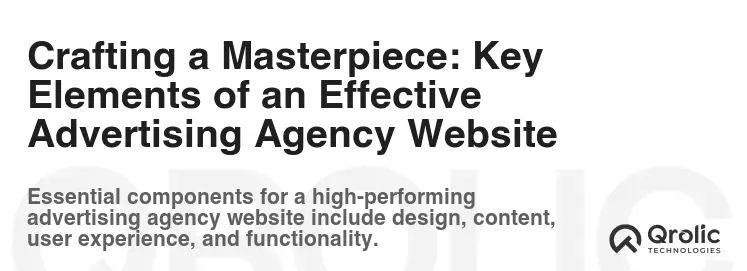
Now that we’ve established why a great website is essential, let’s dive into the specific elements that make up an effective advertising agency website.
Homepage: The Digital Front Door
Your homepage is the most important page on your website. It’s the first impression you make, so it needs to be captivating, informative, and easy to navigate.
- Compelling Headline and Value Proposition: Immediately grab the visitor’s attention with a compelling headline that clearly communicates your value proposition. What problems do you solve? What makes you different?
- Stunning Visuals: Use high-quality imagery and video to showcase your best work and create a visually appealing experience.
- Clear Navigation: Ensure visitors can easily find what they’re looking for. Use clear and concise navigation labels and a well-organized site structure.
- Strategic Calls to Action: Guide visitors through your website and encourage them to take the next step. Use prominent calls to action that are relevant to the content on the page.
- Social Proof: Showcase testimonials, awards, and client logos to build trust and credibility.
About Us: Telling Your Agency’s Story
The “About Us” page is your opportunity to connect with potential clients on a personal level. Tell your agency’s story, share your values, and introduce your team.
- Your Agency’s Story: Share the story of how your agency was founded, what your mission is, and what makes you unique.
- Your Values: Communicate your agency’s values and how they guide your work.
- Your Team: Introduce your team members and highlight their expertise. Include photos and brief biographies to humanize your agency.
- Your Culture: Showcase your agency’s culture and personality. This will help potential clients determine if you’re a good fit for them.
Services: Defining Your Expertise
Clearly define the services you offer and highlight your expertise in each area.
- Clear and Concise Descriptions: Use clear and concise language to describe your services. Avoid jargon and focus on the benefits you provide to clients.
- Showcase Your Expertise: Highlight your experience and expertise in each service area. Include case studies and examples of your work.
- Targeted Calls to Action: Encourage visitors to learn more about your services and contact you for a consultation.
Portfolio: The Showcase of Your Success
Your portfolio is the most important section of your website. It’s where you showcase your best work and demonstrate your ability to deliver results.
- High-Quality Visuals: Use high-quality imagery and video to showcase your campaigns in their best light.
- Detailed Case Studies: Tell the story behind each campaign, including the challenge, the strategy, and the results.
- Filter and Search Functionality: Allow visitors to easily filter and search your portfolio by industry, service, or keyword.
- Mobile-Friendly Design: Ensure your portfolio looks great on all devices.
Blog: Your Platform for Thought Leadership
Your blog is your opportunity to share your expertise, demonstrate your thought leadership, and attract new visitors to your website.
- High-Quality Content: Publish high-quality blog posts that are informative, engaging, and relevant to your target audience.
- Keyword Optimization: Optimize your blog posts for relevant keywords to improve your search engine rankings.
- Social Sharing: Make it easy for visitors to share your blog posts on social media.
- Consistent Posting Schedule: Maintain a consistent posting schedule to keep your audience engaged.
Contact Us: Making it Easy to Connect
Make it easy for potential clients to contact you by including a clear and prominent “Contact Us” page.
- Contact Form: Include a contact form that allows visitors to easily submit their inquiries.
- Phone Number and Email Address: Clearly display your phone number and email address.
- Address and Map: If you have a physical office location, include your address and a map.
- Social Media Links: Include links to your social media profiles.
SEO Strategies for Advertising Agency Websites: Ranking Higher, Attracting More Clients
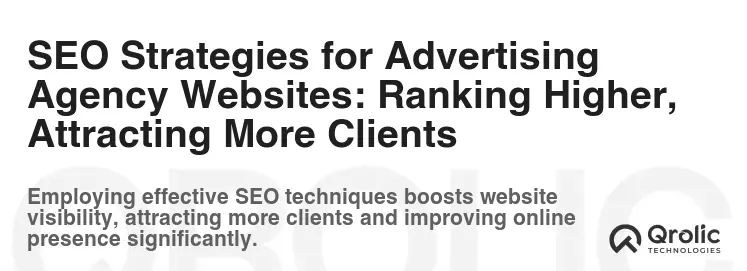
Now let’s talk about how to optimize your website for search engines so you can attract more potential clients. Here are some essential SEO strategies for advertising agency websites:
Keyword Research: Understanding What Your Clients Are Searching For
Keyword research is the foundation of any successful SEO strategy. It involves identifying the keywords and phrases that potential clients are using to search for advertising agencies online.
- Brainstorming: Start by brainstorming a list of keywords related to your services, industry, and target audience.
- Keyword Research Tools: Use keyword research tools like Google Keyword Planner, Ahrefs, and SEMrush to identify high-volume, low-competition keywords.
- Long-Tail Keywords: Focus on long-tail keywords, which are longer and more specific phrases that target a niche audience.
- Competitor Analysis: Analyze your competitors’ websites to identify the keywords they’re targeting.
On-Page Optimization: Making Your Website Search Engine Friendly
On-page optimization involves optimizing your website’s content and structure to make it more search engine friendly.
- Title Tags: Optimize your title tags to include relevant keywords and accurately describe the content of each page.
- Meta Descriptions: Write compelling meta descriptions that encourage users to click on your search results.
- Header Tags: Use header tags (H1, H2, H3, etc.) to structure your content and highlight important keywords.
- Image Alt Tags: Add alt tags to your images to describe the content of the image and improve accessibility.
- URL Structure: Use a clear and concise URL structure that includes relevant keywords.
- Content Optimization: Optimize your content for relevant keywords and ensure it’s well-written, informative, and engaging.
- Internal Linking: Link to other relevant pages on your website to improve navigation and distribute link juice.
Off-Page Optimization: Building Authority and Credibility
Off-page optimization involves building authority and credibility for your website through link building and other external factors.
- Link Building: Earn high-quality backlinks from reputable websites in your industry.
- Guest Blogging: Write guest posts for other websites in your industry and include a link back to your website.
- Social Media Marketing: Promote your website and content on social media to increase brand awareness and drive traffic.
- Online Directory Listings: List your website in relevant online directories.
- Reputation Management: Monitor your online reputation and address any negative reviews or comments.
Technical SEO: Ensuring Your Website is Crawlable and Indexable
Technical SEO involves optimizing your website’s technical aspects to ensure it’s easily crawlable and indexable by search engines.
- Website Speed: Optimize your website’s loading speed to improve user experience and search engine rankings.
- Mobile-Friendliness: Ensure your website is mobile-friendly and responsive to provide a seamless experience on all devices.
- XML Sitemap: Submit an XML sitemap to search engines to help them crawl and index your website.
- Robots.txt File: Use a robots.txt file to control which pages search engines can crawl and index.
- HTTPS Encryption: Secure your website with HTTPS encryption to protect user data and improve search engine rankings.
- Schema Markup: Implement schema markup to provide search engines with more information about your website and content.
The Power of Visual Storytelling: Captivating Website Design for Advertising Agencies

In the world of advertising, visual storytelling is paramount. Your website needs to embody this principle, not just in the portfolio section, but throughout the entire user experience.
Embracing Minimalism: Less is Often More
A cluttered website overwhelms visitors and detracts from your core message. Embrace minimalism to create a clean, modern, and user-friendly experience.
- Whitespace is Your Friend: Use whitespace strategically to create visual separation and improve readability.
- Limited Color Palette: Stick to a limited color palette that is consistent with your brand identity.
- Simple Typography: Choose fonts that are easy to read and visually appealing.
- Focus on High-Quality Visuals: Let your visuals do the talking.
Interactive Elements: Engaging Visitors and Creating a Memorable Experience
Interactive elements can transform your website from a static brochure into an engaging and immersive experience.
- Micro-Interactions: Use micro-interactions, such as hover effects and animations, to provide feedback and enhance the user experience.
- Parallax Scrolling: Implement parallax scrolling to create a sense of depth and visual interest.
- Interactive Infographics: Use interactive infographics to present data and information in a visually appealing and engaging way.
- Quizzes and Polls: Incorporate quizzes and polls to engage visitors and gather valuable insights.
Motion Graphics and Animation: Adding Visual Flair and Dynamism
Motion graphics and animation can add visual flair and dynamism to your website, making it more engaging and memorable.
- Animated Logos: Use animated logos to add a touch of personality and visual interest.
- Explainer Videos: Create explainer videos to communicate complex information in a clear and concise way.
- Animated Transitions: Use animated transitions to create a smooth and seamless user experience.
- Cinemagraphs: Incorporate cinemagraphs, which are still photos with subtle motion, to create a visually captivating effect.
Mobile-First Design: Prioritizing the Mobile Experience
In today’s mobile-first world, it’s essential to prioritize the mobile experience when designing your website.
- Responsive Design: Ensure your website is responsive and adapts to different screen sizes and devices.
- Touch-Friendly Navigation: Design your navigation to be touch-friendly and easy to use on mobile devices.
- Optimized Images: Optimize your images for mobile devices to reduce loading times.
- Mobile-Specific Content: Consider creating mobile-specific content that is tailored to the needs of mobile users.
Measuring Success: Key Metrics to Track and Analyze
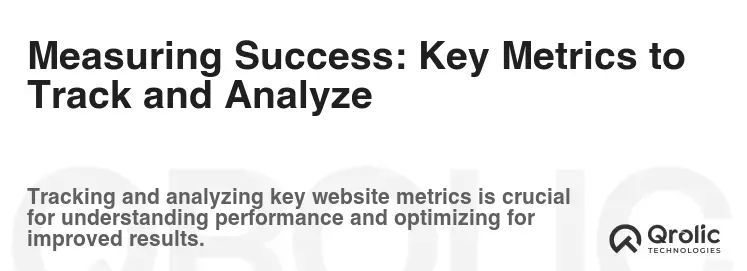
Once your website is live, it’s important to track and analyze key metrics to measure its performance and identify areas for improvement.
Website Traffic: Understanding Your Audience
Website traffic is a fundamental metric that provides insights into the number of visitors your website is attracting.
- Unique Visitors: Track the number of unique visitors to your website to understand your reach.
- Pageviews: Monitor the number of pageviews to see which pages are most popular.
- Traffic Sources: Analyze your traffic sources to understand where your visitors are coming from (e.g., organic search, social media, referrals).
- Bounce Rate: Monitor your bounce rate to identify pages that are not engaging visitors.
- Average Session Duration: Track the average session duration to see how long visitors are staying on your website.
Lead Generation: Measuring Conversion Rates
Lead generation metrics measure the effectiveness of your website in generating leads and converting them into paying customers.
- Conversion Rate: Track the conversion rate of your lead capture forms and calls to action.
- Cost Per Lead: Calculate the cost per lead to understand the efficiency of your marketing efforts.
- Lead Quality: Assess the quality of your leads to ensure they are qualified and likely to convert into customers.
- Sales Qualified Leads (SQLs): Track the number of leads that are qualified for sales and passed on to your sales team.
Engagement Metrics: Gauging User Interaction
Engagement metrics provide insights into how users are interacting with your website and content.
- Time on Page: Track the time on page to see how long visitors are spending on each page.
- Scroll Depth: Monitor scroll depth to see how far visitors are scrolling down your pages.
- Social Shares: Track the number of social shares to see how often your content is being shared on social media.
- Comments: Monitor the number of comments on your blog posts to see how engaged your audience is.
SEO Performance: Tracking Your Search Engine Rankings
SEO performance metrics measure the effectiveness of your SEO efforts in improving your search engine rankings and driving organic traffic.
- Keyword Rankings: Track your keyword rankings to see how your website is ranking for relevant keywords.
- Organic Traffic: Monitor your organic traffic to see how much traffic you’re getting from search engines.
- Backlinks: Track the number and quality of backlinks to your website.
- Domain Authority: Monitor your domain authority to see how authoritative your website is in the eyes of search engines.
Tools for Tracking and Analyzing Website Performance
There are a variety of tools available for tracking and analyzing website performance. Some of the most popular tools include:
- Google Analytics: A free web analytics service that provides comprehensive data about your website traffic, user behavior, and conversions.
- Google Search Console: A free tool that provides insights into your website’s performance in Google Search.
- Ahrefs: A powerful SEO tool that provides data on keyword rankings, backlinks, and competitor analysis.
- SEMrush: Another popular SEO tool that offers a wide range of features, including keyword research, on-page optimization, and competitor analysis.
Qrolic Technologies: Your Partner in Creating Exceptional Advertising Agency Websites

At Qrolic Technologies, we understand the unique needs of advertising agencies. We specialize in advertising agency website development, creating visually stunning, user-friendly, and SEO-optimized websites that help you attract new clients and showcase your creative brilliance. We are experts in creative ad web design and marketing agency website development.
Our Expertise: Delivering Cutting-Edge Web Solutions
We offer a comprehensive suite of Web Development services tailored specifically for advertising agencies, including:
- Custom Website Design: We create unique and visually stunning websites that reflect your agency’s brand identity and showcase your creative work.
- Responsive Web Development: We ensure your website is responsive and adapts to all devices, providing a seamless user experience for your visitors.
- SEO Optimization: We optimize your website for search engines to help you attract more organic traffic and generate leads.
- Content Management Systems (CMS): We build your website on a user-friendly CMS that allows you to easily manage and update your content.
- Portfolio Development: We create interactive and engaging portfolios that showcase your best work in a compelling way.
- E-commerce Integration: If you sell products or services online, we can integrate e-commerce functionality into your website.
- Website Maintenance and Support: We provide ongoing website maintenance and support to ensure your website is always up-to-date and running smoothly.
Why Choose Qrolic Technologies?
- Industry Expertise: We have a deep understanding of the advertising industry and the unique needs of advertising agencies.
- Creative Design: We have a team of talented designers who are passionate about creating visually stunning and engaging websites.
- Technical Excellence: We have a team of experienced developers who are proficient in the latest web technologies.
- SEO Expertise: We have a team of SEO experts who can help you improve your search engine rankings and drive more traffic to your website.
- Client-Focused Approach: We are committed to providing our clients with exceptional service and support.
- Proven Track Record: We have a proven track record of delivering successful website development projects for advertising agencies.
Let’s Build Your Digital Masterpiece
Ready to take your advertising agency’s online presence to the next level? Contact Qrolic Technologies today to schedule a free consultation. We’ll work with you to understand your goals and create a website that helps you achieve them.
Visit us at https://qrolic.com/ to learn more about our services and see examples of our work. Let us help you build a website that captivates, converts, and conquers!
Future-Proofing Your Website: Adapting to the Ever-Evolving Digital Landscape
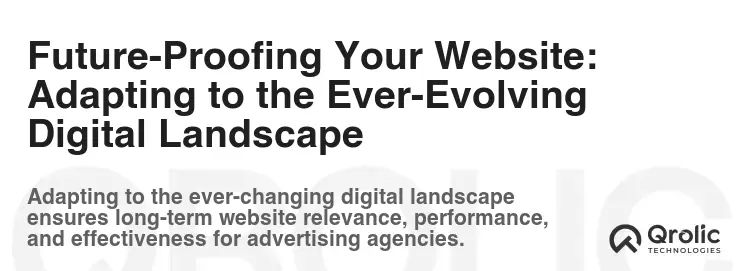
The digital landscape is constantly evolving, so it’s essential to future-proof your website to ensure it remains relevant and effective.
Embracing Emerging Technologies
Stay up-to-date on the latest web technologies and trends, such as:
- Artificial Intelligence (AI): Integrate AI-powered chatbots and personalization features to enhance the user experience.
- Virtual Reality (VR) and Augmented Reality (AR): Explore opportunities to incorporate VR and AR into your website to create immersive experiences.
- Blockchain Technology: Consider using blockchain technology for secure and transparent transactions.
- Progressive Web Apps (PWAs): Develop PWAs to provide a native app-like experience on the web.
Focusing on User Experience (UX)
User experience is more important than ever. Continuously analyze your website’s UX and make improvements based on user feedback.
- User Testing: Conduct user testing to identify areas where your website can be improved.
- A/B Testing: Use A/B testing to experiment with different designs and content to see what works best.
- Personalization: Personalize the user experience based on user data and behavior.
Prioritizing Accessibility
Ensure your website is accessible to all users, including those with disabilities.
- WCAG Compliance: Follow the Web Content Accessibility Guidelines (WCAG) to make your website accessible.
- Screen Reader Compatibility: Ensure your website is compatible with screen readers.
- Keyboard Navigation: Ensure your website can be navigated using a keyboard.
- Alt Text for Images: Add alt text to your images to describe the content of the image.
Staying Ahead of the Curve
The key to future-proofing your website is to stay informed, be adaptable, and continuously innovate.
- Follow Industry Blogs and Publications: Stay up-to-date on the latest web development and marketing trends.
- Attend Conferences and Workshops: Network with other professionals and learn about new technologies and strategies.
- Experiment with New Ideas: Don’t be afraid to experiment with new ideas and technologies to see what works for your agency.
By following these tips, you can ensure that your website remains a valuable asset for your advertising agency for years to come. Your website is not just a website; it’s a living, breathing representation of your brand. Treat it as such, and it will reward you with increased visibility, leads, and ultimately, success.


